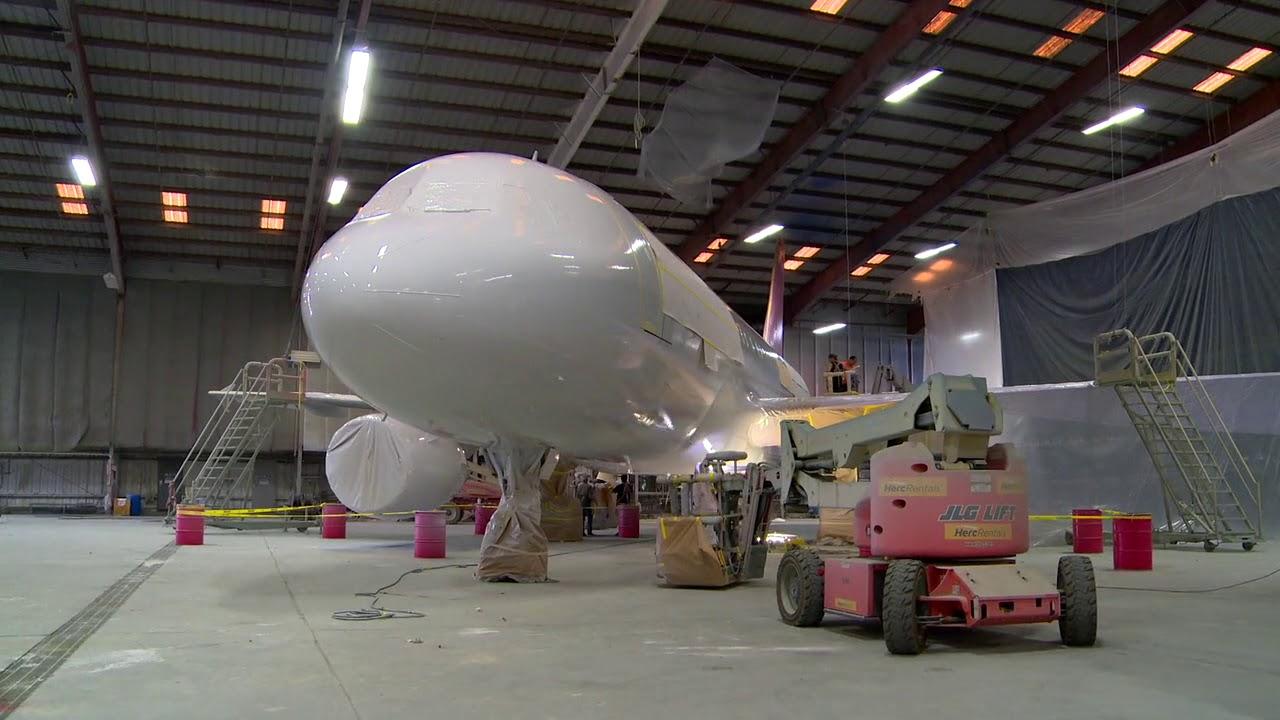
Refreshing liveries on senior jets is a discretionary task, easily delayed during the pandemic. But pulling aircraft out of storage and changing operators is now starting to require more painting. And the painters are looking for more employees to help paint the returning aircraft.
International Aero Coatings started to see demand for aircraft painting slowly increase in the first quarter of 2021, according to sales manager Alicia McCray. “As we approach the third quarter, IAC is running at full capacity across all of our U.S. and European paint hangar locations,” McCrary adds.
IAC has seven U.S. shops and three in Europe. In the first half of 2021 it saw mostly increases in painting requests for Airbus A320s and regional aircraft. Furthermore, “There are a lot of lease transitions happening this year, with more anticipated for 2022,” the IAC manager notes.
Since the pandemic, IAC has painted new liveries for start-up Global Crossing Airlines, a FIFA World Cup 2022 livery for Qatar Airways, Our Commitment and One World liveries for Alaska Airlines, a University of Washington livery for Horizon Air, plus tanker liveries and liveries for Best Jets and Neptune Air Cargo. McCrary says IAC may have a few more up liveries its sleeve that will be debuting soon.
The pandemic initially hit IAC with a delay. In March through May of 2020, the shop actually saw an increase in demand for widebody painting due to many international routes being canceled. “Airlines had excess aircraft and wanted to utilize the short-term route cancellations for paint events, which typically take 10-14 days for a wide body aircraft,” McCray explains.
However, in mid-to-late May of 2020, as airlines understood COVID’s long-term impact, they switched to a cash-preservation strategy. “The demand for paint began to dry up in the airline segment,” McCrary says.
IAC turned to sectors less affected by the pandemic, such as cargo, aerial firefighting and general aviation. Those segments supported the business until the commercial airline paint demand started coming back.
But now that demand is back, there are supply challenges. Paint manufacturers were affected by the pandemic, which necessitated social distancing in their factories and thus reduced staffing for several months.
Coupled with global difficulties in accessing raw materials, this caused short-term supply shortages. By working closely with suppliers and collaborating on forecasts, IAC has been able to overcome the short-term hurdles.
Fortunately, the paint shop retained its experienced painters throughout the crisis. Now it is also running a six-month paid training program at all sites for new hires.
Under this program, which is new for IAC, from 8 to 15 trainees will start each month at each of IAC’s ten sites. Each class will have a dedicated trainer, and trainees will follow a standardized training program for six months with the goal of being promoted to P2-level painter. The program consists of on-the-job, practical and classroom training. In addition, IAC is hiring experienced painters at all facilities.
IAC also used the slack period during the pandemic to invest in facilities. Significant capital expenditures are being made at several U.S. locations, includes installation of new LED lighting, interior cladding and system upgrades. In addition, several new lifts are being purchased.
Dean Baldwin Painting, with shops in five U.S. states, was hit hard initially by the COVID crash. “We immediately lost solid lines of aircraft painting,” says Rick Smith, VP business development. “In March 2020, we went from being at nearly full capacity to nearly empty.”
Airline customers were preserving cash. As a result, Dean Baldwin had months with little or no business in 2020.
But Smith says there is plenty of demand for painting now, and he expects 2022 will be even stronger than 2021. “Our challenge now is hiring and managing the increasing operating cost of labor and materials.”
Recovery came earliest for cargo carriers, including all types from Boeing 757 to 747 freighters. Next regional carriers came back with CRJs and ERJs. “That was the extent of 2020,” Smith says. Now it is looking like smaller narrowbodies will return first and larger widebodies come later as load factors improve.
Dean Baldwin is not yet seeing a significant increase in painting for new liveries with changes in operators. However, Smith has noticed an uptick in regional aircraft coming out of storage and going back into service.
Like IAC, Dean Baldwin has seen an increase in lead times in getting materials from many suppliers. So it is allowing more time for delivery when ordering.
Smith acknowledges that, “New hiring has been tough.” The company kept most of its staff through 2020. “However, as we prepare to increase staffing for a busier aircraft painting schedule in 2021 we are finding it extremely difficult to even get back to pre-pandemic employment levels. We are gaining but it’s a slow process.”
Like IAC, Dean Baldwin has still been investing during the pandemic. It is opening a new aircraft painting facility in Macon, Georgia. “We pushed forward with our expansion plans into Georgia through 2020,” Smith stresses. The new shop will have a soft opening in a few weeks welcoming its first aircraft, a 767 freighter, arriving June 17. A grand opening will be held in September.
“It’s a fabulous all new facility, with four fully equipped hangars designed specifically for aircraft strip and paint services,” Smith says. The Macon shop will have 165,000 square feet of aircraft painting space, capable of painting aircraft as large as a C17 Globemaster III or 767-400. The facility was designed for painting both military and commercial aircraft. “There is a lot of interest in in this location, and slots are filling fast.”
